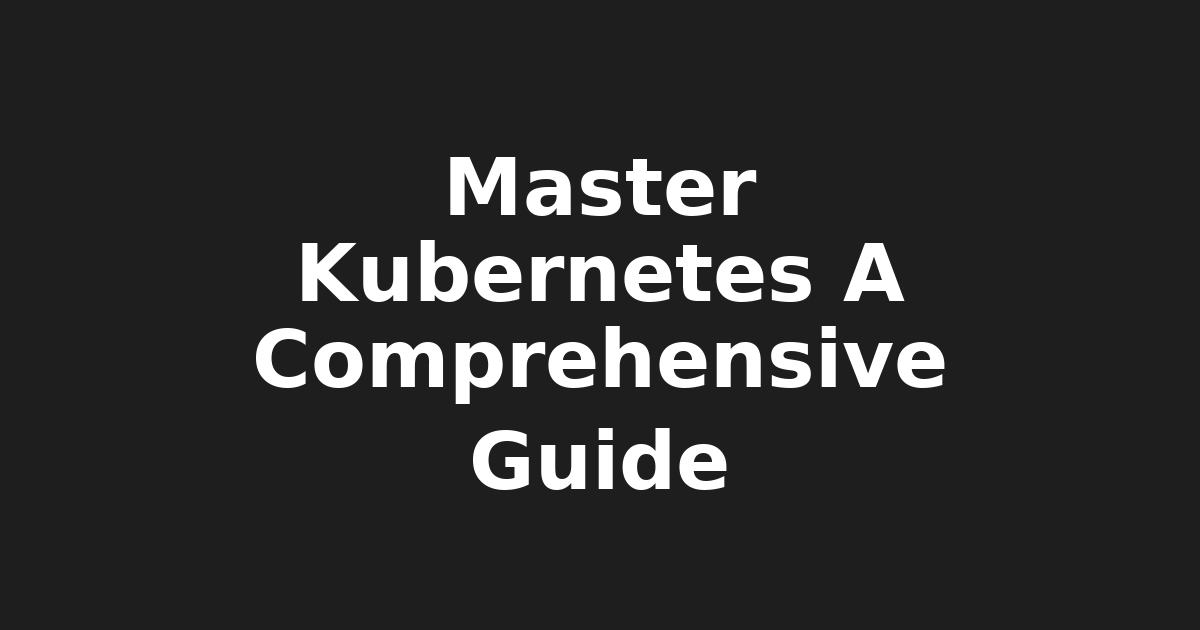Mastering Kubernetes: Ultimate Guide for Devs & Admins in 2023 (Kubernetes,…

Mastering Kubernetes: The Ultimate Guide for Developers and System Administrators in 2023 by Josh from KeepItTechie 📚
Hey there! It's me, Josh from KeepItTechie. You know I love making tech easier to understand, right? Well, today we're gonna talk about something that's been buzzing around the tech world—Kubernetes! If you're a developer, Linux user, system administrator, or just an IT pro looking to level up your skills, this guide is for you.
🎯 What is Kubernetes?
Kubernetes, or K8s, is an open-source platform designed to automate deploying, scaling, and managing containerized applications. It was originally developed by Google and has since become the standard for managing cloud native applications. With the rise of microservices and containerization, understanding Kubernetes is essential for anyone looking to stay ahead in the game.
🔑 Key Concepts
To master Kubernetes, you'll need to know some key terms:
- Pods: The smallest deployable unit in Kubernetes. They contain one or more containers that share the same network namespace and resources.
- Services: A logical abstraction that defines a set of pods and provides a stable endpoint for accessing them.
- Deployments: Managed replica sets for your applications. They ensure the desired number of replicas are running and can handle scaling, updates, and rollbacks.
- DaemonSets: A type of deployment that ensures a copy of each pod is running on all nodes in the cluster to perform tasks like logging or system monitoring.
💻 Installing Kubernetes
Getting started with K8s involves setting up a cluster, which we'll do on Ubuntu or CentOS systems here. You can either install it manually or use tools like kubeadm for an easier setup. (kubeadm docs)
🐳 Working with Containers
To create and manage containers in Kubernetes, you can use tools like Docker and Helm. With Docker, you build your application as a container image, and Helm helps manage these images by packaging them into reusable charts. (Helm docs)
🌐 Monitoring & Troubleshooting
To keep an eye on your cluster, you can use tools like Prometheus and Grafana for monitoring or Kube-ops-view for a GUI dashboard. If something goes wrong, check the logs and events in your cluster to troubleshoot the issue. (Prometheus docs)
🔒 Security
To secure your applications, use Role-Based Access Control (RBAC) for user permissions, Network Policies to control traffic between pods and services, and admissions controllers for validating objects during admission to the cluster. (Kubernetes RBAC)
🔍 Scaling & Optimization
You can scale your applications based on resource requirements using horizontal pod autoscaling or custom controllers like keda for event-driven scaling. For performance optimization, consider using caching, service meshes, and other techniques.
🎉 Advanced Topics
Once you've mastered the basics, explore advanced topics like GitOps for declarative infrastructure management, service meshes for managing network traffic, and multi-cluster management for operating multiple clusters efficiently. (GitOps)
🌐 Use Cases
Kubernetes is versatile—you can use it in various use cases like CI/CD pipelines, machine learning workflows, or serverless architectures. The possibilities are endless! (Kubernetes use cases)
🔎 Staying Up-to-Date
To stay current in the Kubernetes ecosystem, attend conferences like KubeCon, join workshops, and enroll in online courses. The Kubernetes documentation is also a great resource!
💪 Taking Action
By mastering Kubernetes, you'll become an indispensable asset to any tech organization looking to streamline their cloud native deployments. Don't wait—start learning today and unlock the full potential of your skills! 🚀💻🌐
🙋♂️ This post was brought to you by Josh from KeepItTechie — helping you break into tech, one command at a time.
